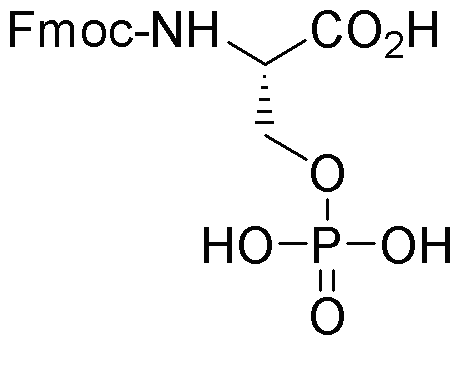Fmoc-O-phospho-L-serine is widely utilized in research focused on:
- Peptide Synthesis: This compound serves as a key building block in the synthesis of phosphopeptides, which are essential for studying protein phosphorylation and signaling pathways.
- Drug Development: It is used in the development of pharmaceuticals that target specific protein interactions, particularly in cancer research, where phosphorylation plays a critical role in tumor progression.
- Bioconjugation: Fmoc-O-phospho-L-serine can be employed in bioconjugation techniques to attach biomolecules to surfaces or other molecules, enhancing the functionality of drug delivery systems.
- Analytical Chemistry: Researchers utilize this compound in various assays to detect and quantify phosphorylated proteins, aiding in the understanding of cellular processes.
- Biotechnology: It is applied in the production of modified proteins for therapeutic use, providing advantages in stability and activity compared to non-phosphorylated counterparts.
General Information
Properties
Safety and Regulations
Applications
Fmoc-O-phospho-L-serine is widely utilized in research focused on:
- Peptide Synthesis: This compound serves as a key building block in the synthesis of phosphopeptides, which are essential for studying protein phosphorylation and signaling pathways.
- Drug Development: It is used in the development of pharmaceuticals that target specific protein interactions, particularly in cancer research, where phosphorylation plays a critical role in tumor progression.
- Bioconjugation: Fmoc-O-phospho-L-serine can be employed in bioconjugation techniques to attach biomolecules to surfaces or other molecules, enhancing the functionality of drug delivery systems.
- Analytical Chemistry: Researchers utilize this compound in various assays to detect and quantify phosphorylated proteins, aiding in the understanding of cellular processes.
- Biotechnology: It is applied in the production of modified proteins for therapeutic use, providing advantages in stability and activity compared to non-phosphorylated counterparts.
Documents
Safety Data Sheets (SDS)
The SDS provides comprehensive safety information on handling, storage, and disposal of the product.
Product Specification (PS)
The PS provides a comprehensive breakdown of the product’s properties, including chemical composition, physical state, purity, and storage requirements. It also details acceptable quality ranges and the product's intended applications.
Certificates of Analysis (COA)
Search for Certificates of Analysis (COA) by entering the products Lot Number. Lot and Batch Numbers can be found on a product’s label following the words ‘Lot’ or ‘Batch’.
Numéro de catalogue
Numéro de lot/série
Certificates Of Origin (COO)
This COO confirms the country where the product was manufactured, and also details the materials and components used in it and whether it is derived from natural, synthetic, or other specific sources. This certificate may be required for customs, trade, and regulatory compliance.
Numéro de catalogue
Numéro de lot/série
Safety Data Sheets (SDS)
The SDS provides comprehensive safety information on handling, storage, and disposal of the product.
DownloadProduct Specification (PS)
The PS provides a comprehensive breakdown of the product’s properties, including chemical composition, physical state, purity, and storage requirements. It also details acceptable quality ranges and the product's intended applications.
DownloadCertificates of Analysis (COA)
Search for Certificates of Analysis (COA) by entering the products Lot Number. Lot and Batch Numbers can be found on a product’s label following the words ‘Lot’ or ‘Batch’.
Numéro de catalogue
Numéro de lot/série
Certificates Of Origin (COO)
This COO confirms the country where the product was manufactured, and also details the materials and components used in it and whether it is derived from natural, synthetic, or other specific sources. This certificate may be required for customs, trade, and regulatory compliance.


